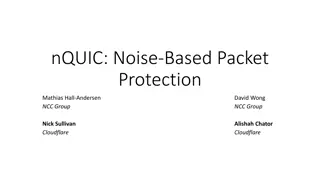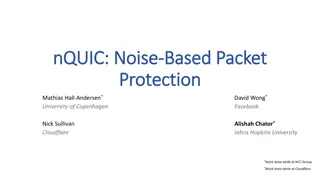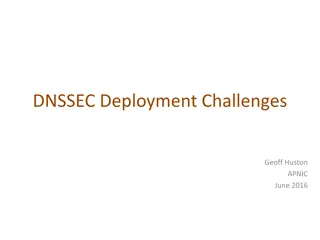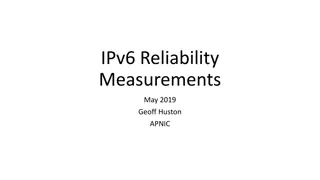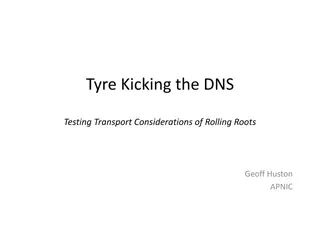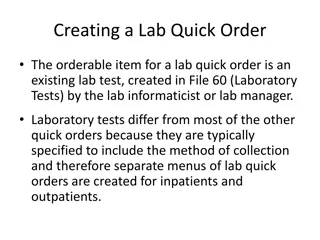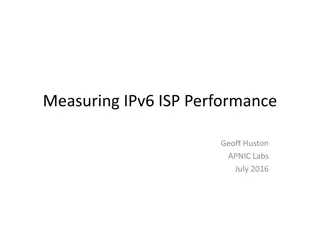Understanding QUIC: A Quick Overview by Geoff Huston
QUIC is a modern transport protocol that improves upon TCP by offering features like improved multi-stream capabilities, encryption, and congestion control. It is built on top of UDP and enables faster, more secure data transfers. QUIC is address-agile, which helps it navigate challenges posed by NATs. Unlike TCP, QUIC shifts transport services towards the application layer, providing benefits like multi-stream multiplexing and faster setup exchanges.
Download Presentation

Please find below an Image/Link to download the presentation.
The content on the website is provided AS IS for your information and personal use only. It may not be sold, licensed, or shared on other websites without obtaining consent from the author. Download presentation by click this link. If you encounter any issues during the download, it is possible that the publisher has removed the file from their server.
E N D
Presentation Transcript
A Quick look at QUIC Geoff Huston
QUIC is QUIC HTTP/3 HTTP/2 HTTP HTTP Multi-stream QUIC TLS Multi-stream Encryption Data stream integrity Congestion Control Session Encryption e2e encrypted TCP e2e encrypted Data stream integrity Congestion Control UDP IP
TCP is.. A transport protocol that constructs a reliable full duplex adaptive streaming service constructed on top of an unreliable IP datagram service Uses a coordinated state between the two end systems without any network intervention or mediation Uses a sliding window to allow lost data to be resent Uses ACK-clocking to regulate the sending behaviour to match network path capacity estimate Has been tweaked to support (*to some degree) multi-stream and RPC transport models
TCP isnt Fully independent of the underlying platform s transport services Fully multi-stream (it has head of line blocking) Free from on-the-wire network intervention (TCP control parameters are sent in the clear) Has e2e encryption as a second step / afterthought Everything for everyone it relies on the application to perform data framing and in-band control
QUIC is Constructed upon a transport level framing protocol that offers applications access to the basic IP datagram services offered by IP through the use of UDP All other transport services (data integrity, session control, congestion control, encryption) are shifted towards the application. A platform may provide a QUIC API, but the application can also provide its own service So much more than encrypted TCP over UDP : Support for multi-stream multiplexing that avoids head-of-line blocking and exploits a shared congestion and encryption state Faster - Combines transport and encryption setup exchange in a single 3-way exchange Customisable - QUIC implementations can use individual flow controllers per flow QUIC places it s transport control fields inside the encryption envelope, so QUIC has minimal exposure to the network Supports record and RPC service models as well as streaming and datagram
QUIC is address agile NATs are hostile to QUIC because of the outer UDP wrapper A NAT may rebind (shift the externally visible address/port of a host during a session), as NATs are not generally aware of UDP streaming states QUIC uses a persistent connection ID If a host receives a QUIC frame with the same connection ID and a new IP address / port it will send a challenge by way of a random value that should be echoed back. This is all performed within the e2e encryption envelope. That way QUIC can map into new address/port associations on the fly
QUIC also Is IP fragmentation intolerant QUIC uses PMTUD, or defaults to 1,200 octet UDP payloads Never retransmits a QUIC packet retransmitted data is sent in the next QUIC packet number this avoids ambiguity about packet retransmission Extends TCP SACK to 256 packet number ranges (up from 3) Separately encrypts each QUIC packet May load multiple QUIC packets in a single UDP frame
QUIC flow structuring A QUIC connection is broken into streams which are reliable data flows each stream performs stream- based loss recovery, congestion control, and relative stream scheduling for bandwidth allocation QUIC also supports unreliable encrypted datagram delivery
QUIC and RPC By associating each RPC request/reply with a new stream QUIC can support asynchronous RPC transactions using reliable messaging This can handle lost, mis-ordered and duplicated RPC messages without common blocking or throttling
QUIC and Load Balancing This assumes that a front-end load balancer is capable of performing load balancing on UDP flows using the UDP connection 5-tuple If the remote end performs NAT rebinding the load balancer will be thrown by this shift, and it has no direct visibility into the e2e session to uncover the connection ID Using UDP to carry sustained high-volume streams may not match the internal optimisations used in server content delivery networks If we really want large scale QUIC with front end load balancing and we still need to tolerate NATs then we will need to think about how the end point can share the connection ID state with its front end load balancer, or terminate the QUIC session in the front end and use a second session to the selected server
QUIC and DOS Very little lies outside the encryption envelope in QUIC Which means all incoming packets addressed to the QUIC port need to be decrypted But the session uses symmetric crypto so the packet decode overhead is far smaller than the asymmetric load Its not the best answer, but its not disastrous either!
Looking for QUIC At APNIC we use Ads to perform large scale measurements of network service capabilities as seen by users IPv6 deployment DNSSEC validation Fragmentation Can we use this measurement platform to see the level of use of QUIC in today s network?
Setting up QUIC Server: nginx v1.21.7 with QUIC functions included DNS: Set up an HTTPS record for each URL with value: alpn= h3 Content: Alt-Svc: h3= :443 (This second method requires a subsequent query to allow the client to use the Alt-Svc capability. We perform a delayed second query for this URL in the measurement experiment)
Two QUIC triggers, two behaviours The Safari browser (V16) is triggered by the presence of the DNS HTTPS record with an alpn value of h3 Once established, the browser client expects the server to keep the QUIC session open. If the session is closed prematurely Safari will drop back to HTTP/2 over TCP/TLS What s premature in seconds? I dunno! More than 1 second. Less than 65 seconds. We use a server session keepalive interval of 20 seconds and that seems to work
Two QUIC triggers, two behaviours The Chrome browser is triggered by the content directive within the delivered page But this creates an issue with HTTP/2 and persistent connection support When the browser performs the followup fetch after the initial fetch, the connection is likely still open. The browser will prefer to use the open connection rather then opening up a new QUIC connection, despite the inclusion of a content directive. So this in-content signalling is not all that effective as a QUIC trigger. How long should we wait before performing the second query? Or how long should we set the server s keepalive persistence timer? I dunno! More than 1 second. Less than 65 seconds. We use a keepalive interval of 20 seconds and that seems to work
Measuring QUIC use 2nd and subsequent fetches First fetch
Why? If both Safari and Chrome support QUIC these days then why is the measurement number not closing in on 100%? I suspect its about many enterprise environments blocking UDP port 443 And some ISPs And of course the Great Firewall of China
Is QUIC Faster? Let s compare the user-measured time to load an object using HTTP/2 and the same user s measured time to load the same object using HTTP/3 There are a number of variables in the user time measurement, including varying time penalties relating to the internal task scheduling within the browser, but these individual factors should be cancelled out over a large enough sample set
Is QUIC faster? Area where QUIC is faster ms Non-QUIC Faster QUIC Faster
Is QUIC faster? HTTP/3 is faster to perform object retrieval in 2/3 of the observed cases ms Non-QUIC Faster QUIC Faster
Thanks! Ongoing HTTP/3 Measurement Report at APNIC Labs: https://stats.labs.apnic.net/quic





